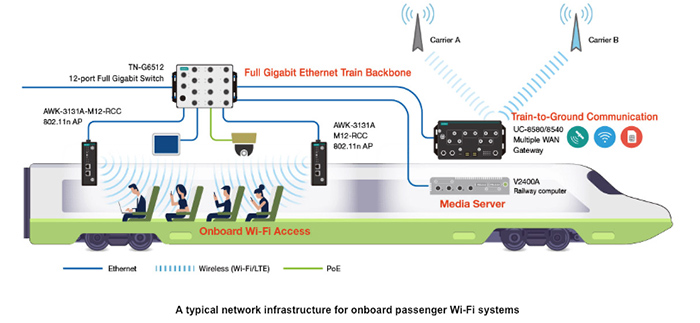In the recent decade, the widespread utilization of mobile gadgets for gathering information and communication has transformed the expectations of travelers concerning rail journeys. Apart from desiring a pleasant trip, passengers are now increasingly requesting access to the internet and the capability to work while aboard a train to maximize their travel time efficiently. In addition to basic internet access, railway companies have also started to realize that they can use onboard Wi-Fi networks for supporting a range of operational and passenger entertainment applications. A digitally connected fleet facilitates real-time reporting of system status and enhances information dissemination. These services enhance operational effectiveness, reduce expenses, elevate service quality, and enhance customer contentment.
Five Strategies for Effective High-Capacity Wi-Fi Installation
Here are the leading five elements to take into account when selecting a Wi-Fi solution for high-capacity Wi-Fi deployments in industrial settings—beyond facilitating the same standard features as a general-purpose access point (AP).
1. Dependability
An AP holds a crucial role in linking passengers to the onboard Wi-Fi network on a train. While numerous corporate solutions already offer such connectivity, only a few can satisfy the demands of rolling-stock operations. Access points suitable for use on trains should encompass the subsequent features:
- Broad operating temperature range
- Anti-vibration and anti-shock connection design
- Dual isolation safeguard (RF and power)
- Versatile power input
2. Superior Bandwidth
Estimating the bandwidth required by each passenger for seamless network connectivity while traveling is challenging. Projections are typically influenced by studies that contemplate user actions and the bandwidth consumed by assorted onboard applications. In a typical household or office, a data transfer rate of 50 to 100 Mbps is ample for enabling simultaneous internet access across multiple devices. Nevertheless, considering that passengers could possess numerous devices and various factors constraining AP throughput, one study has revealed that passengers often end up with just 2 to 3 Mbps of bandwidth for their applications.

3. Peak-Density Connectivity
In scenarios where a conventional wireless network is deployed in a high-density user ambiance, poor user experience is easily foreseeable. This issue is more noticeable at live events and in trains, where numerous users endeavor to access a Wi-Fi network simultaneously. To guarantee an optimal user experience, one study suggests deploying one AP for every 60 users. For example, a train compartment accommodating 100 passengers will necessitate at least two APs, each equipped with both 2.4 GHz and 5 GHz channels, catering to as many passengers as feasible across distinct bands. Inadequate AP deployment could lead to certain passengers experiencing substandard connection quality.
4. Even Client Distribution
When an excessive number of client devices attempt to connect to an AP, the available bandwidth for each client device diminishes, ultimately culminating in inadequate connectivity. Via client-distribution balancing, railway companies can restrict the count of client devices able to link up to an AP. Once this limit is attained, the AP can reject any fresh connection requests, compelling client devices to connect to other APs and, as a result, equitably distributing the available radio channels amongst all client devices in the vicinity. Moreover, client-distribution balancing allows APs to prevent client devices from connecting to an overloaded channel, hence encouraging an equitable allocation of accessible bandwidth for all client devices.
5. Wireless Client Segregation
To avoid client devices in a public Wi-Fi network from communicating with one another, railway companies must implement client segregation. These devices should only be granted access to the internet. This approach serves a dual purpose: it enhances network security and restricts broadcast traffic. Every device linking to onboard APs is part of the same network, encompassing onboard systems such as broadcast or other control systems. However, unlike a household network where resource access across different devices is unrestricted, passengers and train operators do not need mutual device access. In reality, they prefer not exchanging resources and information with others, particularly on a public wireless network where the risk of a security breach is elevated.

Enhancing Onboard Wi-Fi for Passenger Contentment
Let’s examine a standard usage scenario of onboard Wi-Fi for train passengers to grasp what it requires to provide an excellent user experience.
System Prerequisites
- Consistent Wi-Fi connectivity
- Sufficient bandwidth for swift internet access
- Built-in network intelligence that seamlessly adapts to daily inter-car and inter-consist modifications
- Straightforward, adaptable, and reliable routing across diverse locations and IP service providers
- Operational stability for device longevity and network connectivity
- Compact dimensions accommodating space-constrained train environments
Moxa’s Proposition
The majority of passenger Wi-Fi systems are developed tailor-made and designed to fit specific train-car conditions and needs. It is vital to collaborate with firms possessing extensive experience in meeting custom application requirements by offering tailor-made products and engineering services. The following diagram illustrates a passenger Wi-Fi solution that bolsters network performance by furnishing multiple redundant WAN connections, a complete-Gigabit framework, and broad Wi-Fi access. A range of technologies is at disposal to effectuate network reliability, availability, and seamless operation and maintenance, while simultaneously simplifying the deployment process.

The creation of a high-capacity Wi-Fi network is a multifaceted endeavor. By weighing several consequential factors like network reliability, data rate, client ratio mixture, load balancing, and network security, railway operators can select an efficient Wi-Fi solution meeting the requisites of rolling-stock applications and ensuring uninterrupted connections for passengers on pleasant journeys. For additional insights on how to implement passenger Wi-Fi, download our White Paper or visit our microsite.
- Not Only for Automobiles: Discovering CANbus Technology in Various Industrial Settings - October 29, 2024
- Boost Your Network Performance: An Exciting Manual to PoE Switches! - September 10, 2024
- Understanding Gigabit Switches: Industrial vs Regular Gigabit - September 4, 2024


